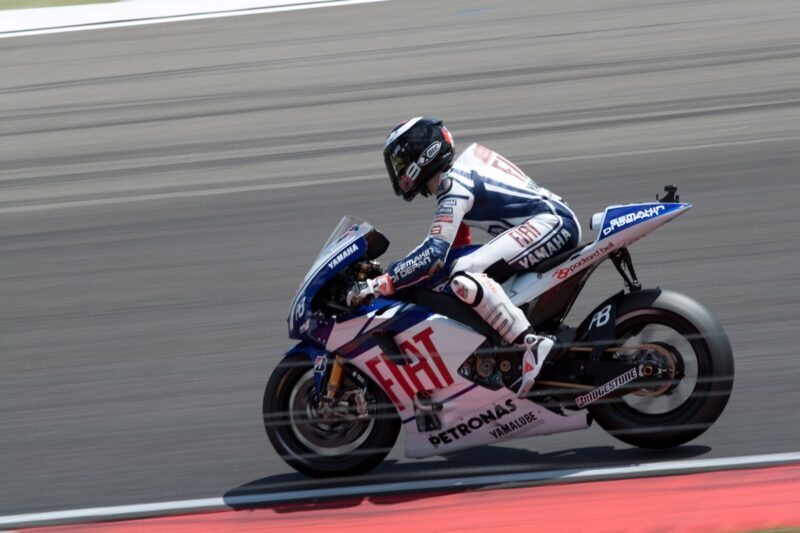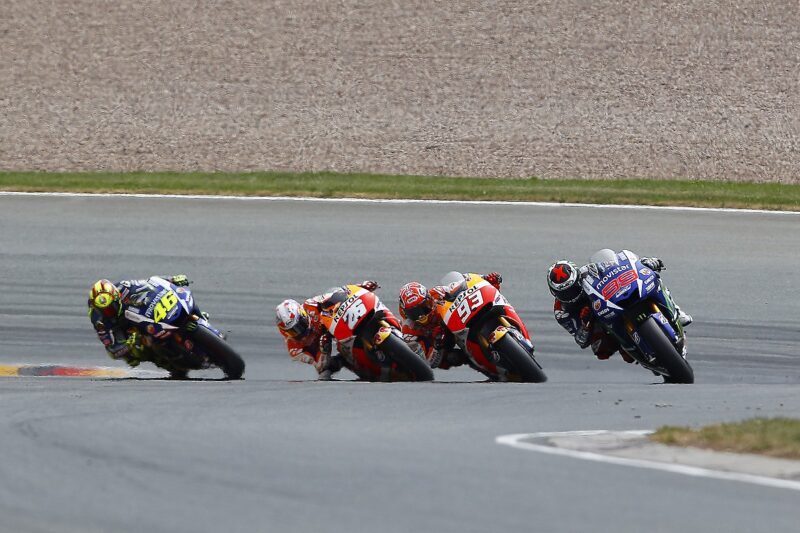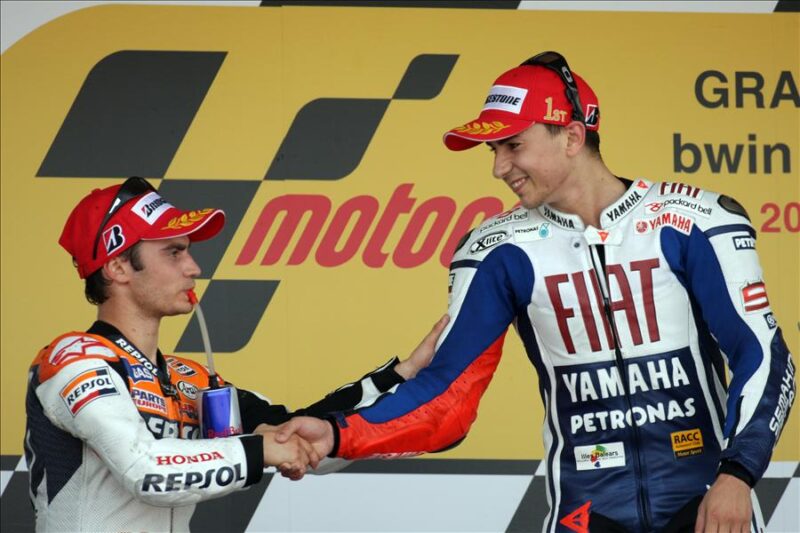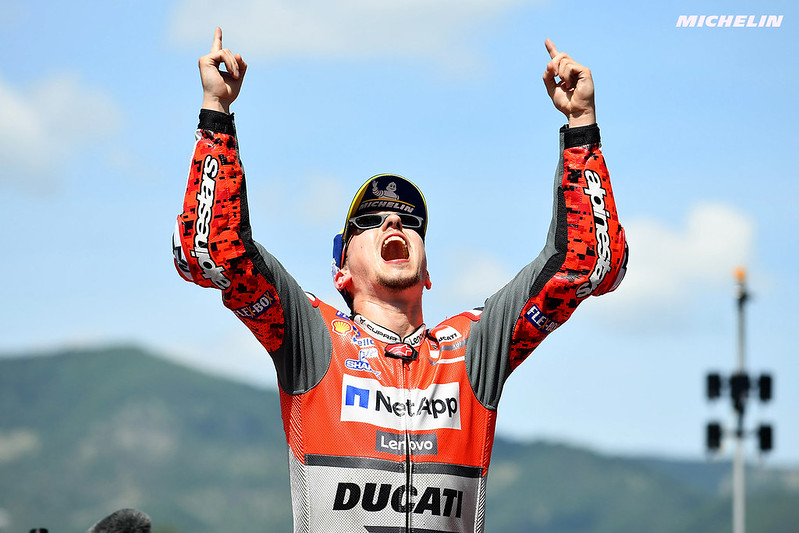Jorge Lorenzo holds a special place in the history of motorcycle sport. He has long been the main antagonist, the “bad boy” in the story. But ultimately, what made him so special and why is he missing from current MotoGP? Together, let's try to answer this question.
I) Perfect piloting?
Let's start there. Lorenzo, it was above all a talent beyond measure. His flawless piloting allowed him to achieve feats. On a good day, no one could do anything about it “Por fuera”, and many have broken their teeth. Roughly, his style consisted of a pure form, without jerks, with, as a result, an astonishing speed of passage in curves. The qualities of the Yamaha crossplane four-cylinder inline allowed it to be unreachable in turns. Jorge could spend every lap in the same place, and this was particularly noticeable from the sidelines.
Its regularity should be studied in all driving schools, always within the same tenth of a second over more than twenty loops.
Metronome qualities that he knew how to adapt to Michelin tires andSingle ECU in 2016 (victories in Qatar, Le Mans and
Mugello with the manner, among others), but also to the Ducati, which, once adjusted according to his desires, was a contender for victory. When things were going well and he was on one of his favorite tracks, it was almost impossible to pass him. Moreover, over the period 2009-2015, everyone went through it and no one really found the solution.. Of course, things could go wrong when the weekend didn't go his way, especially in the rain after his accident at Assen in 2013. But overall, he had no weak points: intrinsic speed (qualifying as well as race pace), overtaking (a very underrated aspect of its profile), strong on the brakes but also on acceleration, one of the best racing IQs of all time…he was ahead of his time. Today, there are many pilots who enjoy similar characteristics, and Lorenzo is easily found in Quarterly,
bagnaia et Martín.

Photo: Jerko Scholten
II) A careful image
The main difference with all current drivers is here. Lorenzo, undoubtedly inspired by Valentino Rossi, was very much into aesthetics. Thus, he developed a strong, marked visual universe, with which it was easy to identify. We can review it, starting with its distinctive sign, a cross surrounded by an arrow. These brands date from another time, when Grand Prix drivers (motorcycles and cars) put a particular signature on the helmet so that it was immediately recognizable, without sponsors. This badge, the “Por fuera” (“from the outside” in French) recalled his sensational overtaking during the 2003 Brazilian Grand Prix, where he passed several pilots from the outside.
Then, Lorenzo folklore expands with the
Mamba, this very dangerous snake which inspired the basketball legend Kobe Bryant. He declined his helmets in relation to the reptile in two versions, namely the
“Black Mamba” and
“Green Mamba” several years later. Overall, only Rossi rivals it with its helmet decorations. We do not count the references to space, with, it goes without saying, the “Lorenzo moon”, directly copied from the design of an astronaut helmet, and taken again in Indianapolis in 2015 for a second version. The development of this universe continues until the establishment of a philosophy, namely the “hammer and butter”, or “martillo and mantequilla” in Spanish. Lorenzo wanted to be soft as butter, but also hard as a hammer when it came to striking the entire grid. A symbolism which perhaps inspired Lewis Hamilton and his
“Hammer time”. We cannot even mention its celebrations, each as iconic as the other, of “man on the moon” à
Laguna Seca up to the cinema spectator at Le Mans. Today, drivers think less about shaping their image and that's quite a shame, because it allows strong memories to be anchored in the minds of fans, and to last even after retirement.
Jorge has not simply lived through the years, he has done more than that, leaving his original mark on an era.

The fantastic four, with Jorge Lorenzo in the lead, as is often the case. Photo: Box Repsol
III) His character
Nowadays, many deplore the lack of rivalry in MotoGP. Moreover, we will soon return to this question which we consider particularly important. Lorenzo had a character apart; he did not want to please the majority, and did not care about being seen as the bad guy. His rivalry with Rossi (without a doubt the most adored driver in the history of Grands Prix) is still on everyone's minds. But this was only possible thanks to Jorge's talent, on the one hand, but also to his character. Indeed, Valentino has found his perfect opponent in Lorenzo.
Unlike Marquez, “Por Fuera”
did not hesitate to tickle Vale' on his own turf, at a press conference, in front of everyone. Whistled on all the podiums, he didn't care, and played the role of the villain to perfection. This almost theatrical aspect generated passion, because we had the impression of witnessing a battle of giants given the level displayed. This controlled arrogance coupled with this suspicion of bad faith benefited the MotoGP spectacle, which is not just about overtaking.
It is for this same reason that Rossi has always respected Lorenzo, and why the two "officially" reconciled after the 2018 Catalan Grand Prix. Today, almost 10 years later, we affirm that this rivalry is the second largest in the history of motor sports behind that of
Senna et Cheers, and not just because Rossi and Lorenzo were trading blows on the track:
Jorge stood up, alone against everyone, against the greatest.
Here are some elements that can help you understand who Jorge Lorenzo was, and again, we haven't talked about his incredible track record, his exploits (Le Mans 2008, Assen 2013, among others) or his other great rivalry with Dani Pedrosa, much deeper. Maybe for another episode? Tell us what you thought of Jorge in the comments!

Lorenzo and Pedrosa, best enemies. Photo: Box Repsol
Cover photo: Michelin Motorsport




